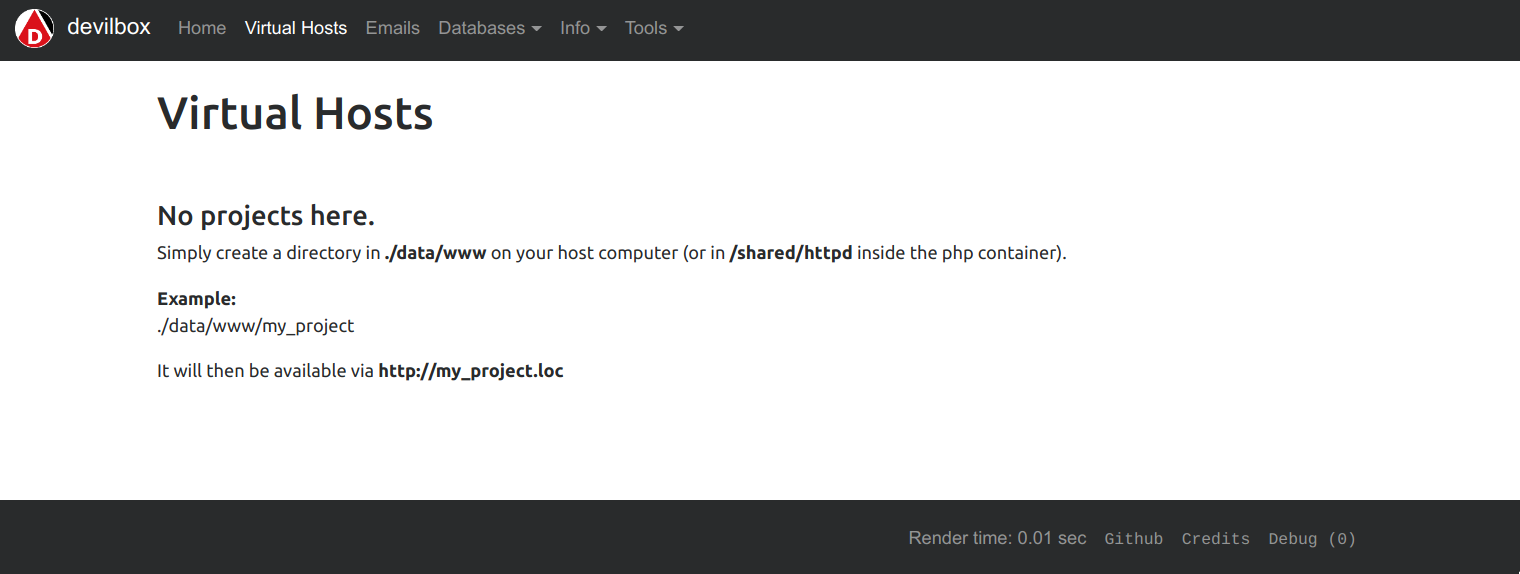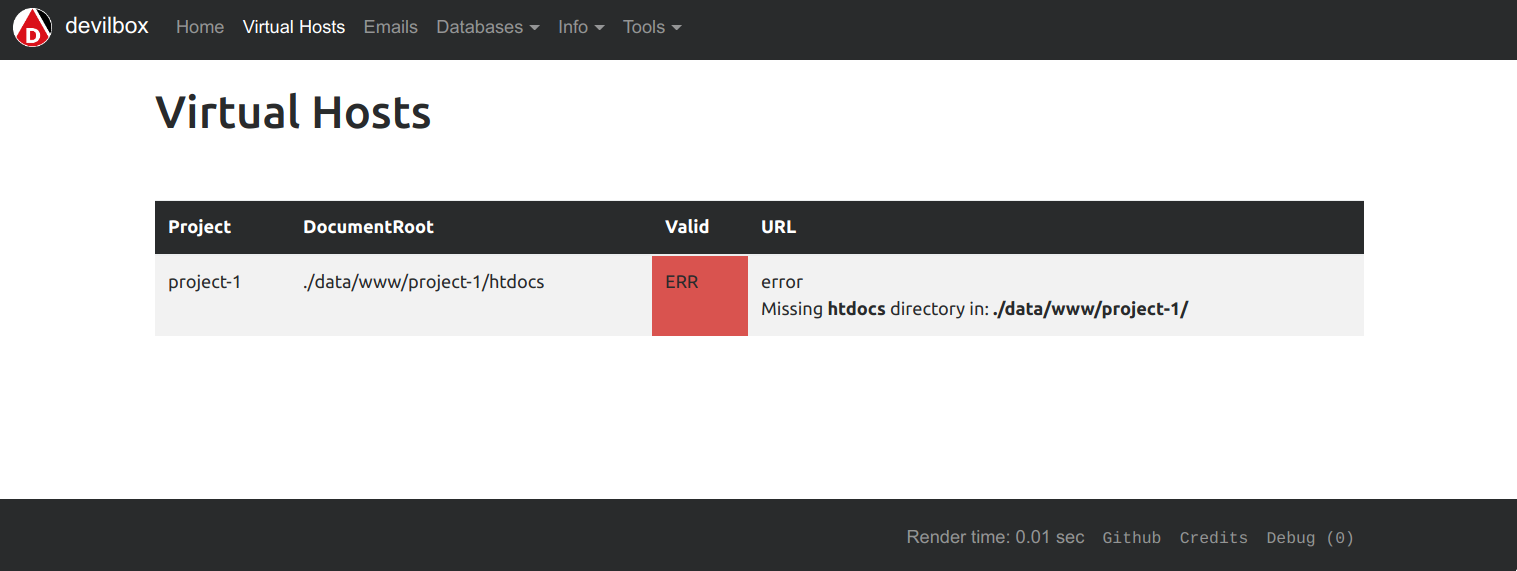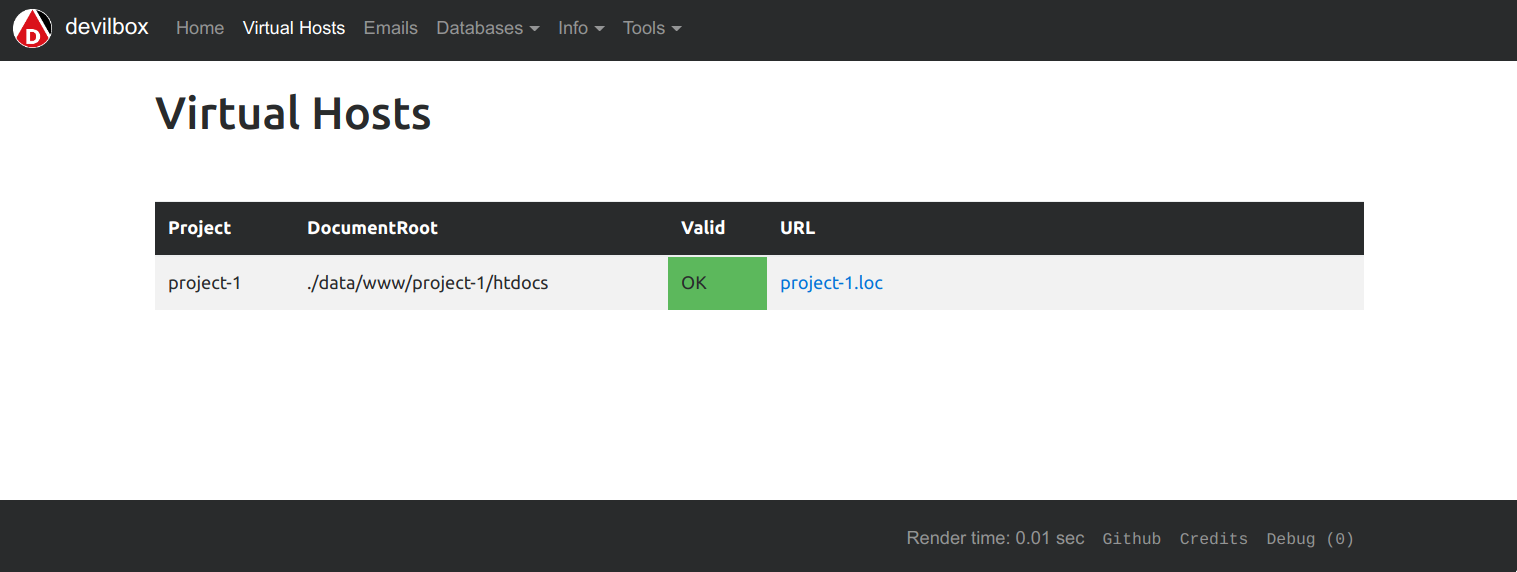Attention
You can now run different PHP versions per project:
Release v3.0.0-beta-0.1 ![]()
6. Create your first project¶
Important
Ensure you have read Directory overview to understand what is going on under the hood.
Note
This section not only applies for one project, it applied for as many projects as you need. There is no limit in the number of projects.
Table of Contents
6.1. Step 1: visit Intranet vhost page¶
Before starting, have a look at the vhost page at http://localhost/vhosts.php or http://127.0.0.1/vhosts.php
See also
It should look like the screenshot below and will actually already provide the information needed to create a new project.

Devilbox intranet: no projects created
6.2. Step 2: create a project directory¶
In your Devilbox git directory, navigate to ./data/www and create a new directory.
Note
Choose the directory name wisely, as it will be part of the domain for that project.
For this example we will use project-1 as our project name.
# navigate to your Devilbox git directory
host> cd path/to devilbox
# navigate to the data directory
host> cd data/www
# create a new project directory named: project-1
host> mkdir project-1
Visit the vhost page again and see what has changed: http://localhost/vhosts.php

Devilbox intranet: misssing htdocs directory
So what has happened?
By having created a project directory, the web server container has created a new virtual host. However it has noticed, that the actual document root directory does not yet exist and therefore it cannot serve any files yet.
6.3. Step 3: create a docroot directory¶
Note
As desribed in Docroot directory the docroot directory name must be htdocs for now.
Navigate to your newly created project directory and create a directory named htdocs inside it.
# navigate to your Devilbox git directory
host> cd path/to devilbox
# navigate to your above created project directory
host> cd data/www/project-1
# create the docroot directory
host> mkdir htdocs
Vist the vhost page again and see what has changed: http://localhost/vhosts.php

Devilbox intranet: misssing dns record
So what has happened?
By having created the docroot directory, the web server is now able to serve your files. However it has noticed, that you have no way yet, to actually visit your project url, as no DNS record for it exists yet.
The intranet already gives you the exact string that you can simply copy into your /etc/hosts
(or C:\Windows\System32\drivers\etc for Windows) file on your host operating system to solve
this issue.
6.4. Step 4: create a DNS entry¶
Note
This step can also be automated via the bundled DNS server to automatically provide catch-all DNS entries to your host computer, but is outside the scope of this getting started tutorial.
When using native Docker, the Devilbox intranet will provide you the exact string you need to paste
into your /etc/hosts (or C:\Windows\System32\drivers\etc for Windows).
# Open your /etc/hosts file with sudo or root privileges
# and add the following DNS entry
host> sudo vi /etc/hosts
127.0.0.1 project-1.loc
Vist the vhost page again and see what has changed: http://localhost/vhosts.php

Devilbox intranet: vhost setup successfully
So what has happened?
By having created the DNS record, the Devilbox intranet is aware that everything is setup now and gives you a link to your new project.
6.5. Step 5: visit your project¶
On the intranet, click on your project link. This will open your project in a new Browser tab or visit http://project-1.loc

Devilbox project: misssing index.php or index.html
So what has happened?
Everything is setup now, however the webserver is trying to find a index.php file in your document root which does not yet exist.
So all is left for you to do is to add your HTML or PHP files.
6.6. Step 6: create a hello world file¶
Navigate to your docroot directory within your project and create a index.php file with some output.
# navigate to your Devilbox git directory
host> cd path/to devilbox
# navigate to your projects docroot directory
host> cd data/www/project-1/htdocs
# Create a hello world index.php file
host> echo "<?php echo 'hello world';" > index.php
Alternatively create an index.php file in data/www/project-1/htdocs with the following contents:
<?php echo 'hello world';
Visit your project url again and see what has changed: http://project-1.loc

Devilbox project: hello world on index.php
6.7. Checklist¶
- Project directory is created
- Docroot directory is created
- DNS entry is added to the host operating system
- PHP files are added to your docroot directory
See also
6.8. Further examples¶
If you already want to know how to setup specific frameworks on the Devilbox, jump directly to their articles:
See also
Well tested frameworks on the Devilbox